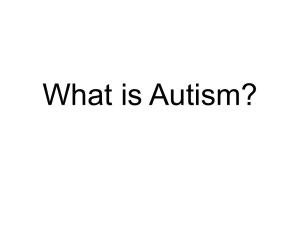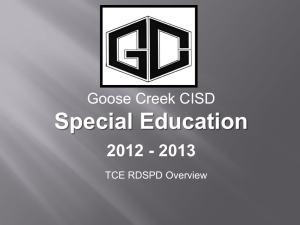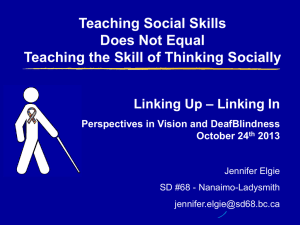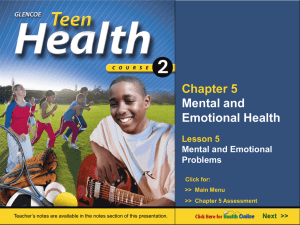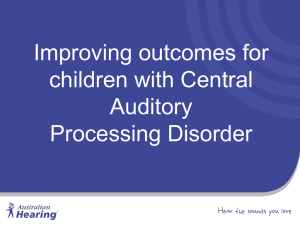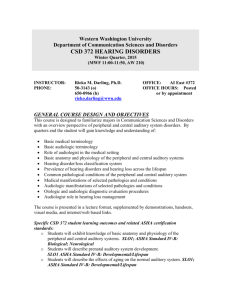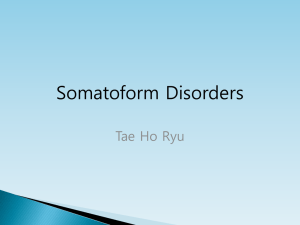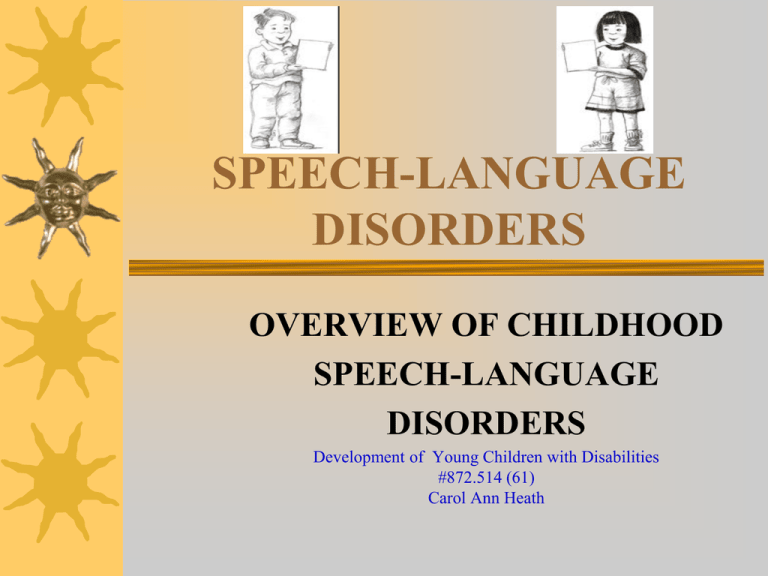
SPEECH-LANGUAGE
DISORDERS
OVERVIEW OF CHILDHOOD
SPEECH-LANGUAGE
DISORDERS
Development of Young Children with Disabilities
#872.514 (61)
Carol Ann Heath
Sources Used:
Hart, B. (2000). A natural history of early language Experience. TECSE 20:1, 28-32.
Lesaux, N. K. (2004 Presentation at Ready by Five Symposium, Baltimore, Maryland)
Promoting Language and Literacy in Young Children from Diverse Backgrounds.
Lyon, G. R. What Happens Early Really Matters. Informal Presentation In Maryland.
Source: National Institute of Child Health and Human Development.
Child Development Institute,
http://www.childdevelopmentinfo.com/disorders/children_with_communication_disord
ers.shtml
Language
Can be defined as a set of symbols used
for communication
Symbols are used to organize thoughts
and new learning and to communicate
with others
May be spoken or take a visual form as
through gestures or written language
Language
Involves the understanding and use of
sounds, words, and the rules for
combining their use
Involves both receptive and expressive
processes
Development of Oral
Language
Involves the understanding and use of
* Phonology
* Semantics
* Morphology
* Syntax or grammar
* Pragmatics
Phonology
Refers to the sound system of a language
and the rules that govern the sound
combinations
Research has demonstrated that by the
age of six months, infants have learned
to differentially respond to the sounds of
their native language
Semantics
Refers to the system that governs the
meanings of words and sentences
Morphology
Refers to the system that governs the
structure of words and the construction
of word forms
Syntax
Refers to the system governing the order
and combinations of words to form
sentences, and the relationship among
the elements of the sentence
Pragmatics
Refers to the system that combines the
above language components in
functional and socially appropriate
communication
May involve the tone of voice used, rules
for turn-taking in conversation, facial
expressions and gestures used to
accompany speech
Normal Language
Development
Language develops rapidly and easily in
most children despite variation in
environment and intelligence
Communication Disorder
An impairment in the ability to receive,
send, process, and comprehend concepts
or verbal, nonverbal and graphic symbol
systems
May be evident in the processes of
hearing, language, and/or speech
Communication Disorder
May range in severity
May be developmental or acquired
May result in a primary disability or it
may be secondary to other disabilities
Prevalence
Rates vary from 2-3% to about 20 %
depending upon the age of the children
studied
10% of children will have a moderate to
severe speech and/or language delay at
eh time of school entrance
Language Disorder
Impaired comprehension and/or use of
spoken, written and/or other symbol
systems
May involve the form of language
(phonology, morphology, syntax), the
content of language (semantics), and/or
the function of language (pragmatics) in
any combination
Children At Risk for
Language Delay
Intellectual disability
Hearing Loss
Central Nervous System Impairment
affecting the speech production
mechanism
Autism Spectrum Disorders
Emotional Disturbance
Extreme environmental deprivation
Child Language
Impairments
Difficulty understanding and using language
to communicate
Problems understanding and using
appropriate vocabulary, word order, or
grammar and difficulty following directions or
some have difficulty using language, and
difficulty staying on topic in a conversation
are common characteristics
Child Language –child may
have some of the following:
Difficulty breaking down language into
its parts
Difficulty with social rules of
conversation
Infrequently initiating conversation or
topics
Child Language – may have
some of the following
Delay in onset of
Incorrect grammar
language development
Difficult following
directions
Problems understanding
wh- questions
Difficulty with abstract
language
usage
Difficulty recalling
words
Frequent use of nonspecific words
Stories, written and
spoken, are disjointed
and miss details
Child Language – possible signs of
underlying language impairment
Easily distracted
Limited attention span
Slower to respond or answer questions
Slower to put thoughts together to
express their ideas
Seems vague – disorganized behavior
Lack of planning and sequencing
Speech Disorder
An impairment of the articulation of
speech sounds, fluency and/or voice
Articulation Impairments
The atypical production of speech
sounds characterized by substitutions,
omissions, additions or distortions that
may interfere with intelligibility
Articulation Impairment
May be caused by a problem in the
mouth or nose structures that are used
for speech (cleft palate or severe tongue
tied)
May be caused by an abnormality in the
function of the muscles or nerves in
speech production (cerebral palsy)
Some may have no apparent cause
Dyspraxia of Speech
An inability to perform the very fast
mouth/tongue movements for speech
when there is no hearing, perception, or
motor problems
As known as developmental apraxia of
speech, developmental verbal dyspraxia,
or developmental articulatory dyspraxia
Characteristics of Dyspraxia
Searching or “groping” movements noted
during attempts to produce speech sounds
Child can produce some sounds at certain
times and not at other times “volitional” or
deliberate production may be more difficulty
than spontaneous production
Sound errors are inconsistent
Characteristics of Dyspraxia
Does not exhibit typical development
speech sound errors
Difficulty with fast repeated speech
sequences
Voice Disorder Definition
Characterized by the abnormal
production and/ or absences of
vocal quality, pitch, loudness,
resonance, and/ or duration, which
is inappropriate for an individual’s
age and/ or sex
Types of Voice
Disorders
Quality – hoarseness, hyper/hypo
nasality, breathiness
Pitch – pitch breaks, monotone, to
high/too low
Loudness – too soft/too loud,
inappropriate for situation
Causes of Voice Disorders
May result from physiological changes in
the body, such as cancer, severe allergies,
or asthma
Organic factors may include vocal nodules
and polyps on the vocal cords
Stuttering of Fluency
Disorder: Definition
Is an interruption in the flow of speaking
characterized by atypical rate, rhythm,
and repetitions in sounds, syllables,
words, and phrases
May be accompanied by excessive
tension, struggle, behavior, and
secondary mannerisms
Characteristics of Stuttering
Primary – hesitations; repetitions and
prolongations of sounds, syllables, words
or phrases; and difficulty initiating
speech
Secondary – facial grimaces, eye
blinking, generalized body tension, and
gasping for air
Causes of Stuttering
Several theories about the causes of stuttering
exists
“underlying motor problem” – causes
Difficulty planning a sequence of speech
movements
“stress related”
“difficulty coordinating the onset of voice with
breathing and production of speech sounds”
Hearing Disorder
The result of impaired auditory
sensitivity of the physiological auditory
system
May limit the development,
comprehension, production, and/or
maintenance of speech and/or language
Referred to as “deaf or hard of hearing”
Deaf
A hearing disorder that limits an
individual’s aural/oral communication
performance to the extent that the
primary sensory input for
communication may be other than the
auditory channel
Hard of Hearing
A hearing disorder, whether fluctuating
or permanent, which adversely affects
an individual’s ability to communicate.
The Hard of Hearing individuals relies
on the auditory channel as the primary
sensory input for communication
Central Auditory
Processing Disorders
Deficits in the information processing of
audible signals not attributed to impaired
peripheral hearing sensitivity or intellectual
impairment
Limitations in the ongoing transmission,
analysis, organization, transformation,
elaboration, storage, retrieval, and use of
information contained in audible signals
Behaviors Associated
CAPD
Poor phonological sensitivity combined with
deficits in fine auditory discrimination
Auditory comprehension problems due to
limited word discrimination and auditory
memory
Difficulty procession verbal information
where there is competing background noise
Behaviors Associated
with CAPD
Diminished word discrimination in a
poor acoustic environment or when a
message is altered in some way
Difficulty following directions
Easily distracted
May have poor performance in reading,
spelling, and other language-related
areas compared to peers
Associated Conditions
Learning disability
Autism Spectrum Disorder
Traumatic Brain Injury
Language Learning Disabilitiesproblems may include:
Age-appropriate
reading, spelling,
and/or writing
Difficulty
understanding and
retaining info
Difficulty expressing
ideas coherently
Difficulty with
reading
comprehension
Difficulty with
learning new
vocabulary
Autism Spectrum Disorder
Communication problems vary
depending upon the intellectual and
social development of child
Some may be unable to speak, while
others may have rich vocabularies
Communication issues in Autism
Spectrum Disorder
Difficulty using
language effectively
Difficulty with topic
maintenance
Echolalia
Problems with word
Poor eye contact
Difficulty with topic
initiation
and sentence
meaning, intonation,
and rhythm
Communication IssuesTraumatic Brain Injury
Slowed processing
and poor memory
Impaired ability for
self management
Disorientation and
confusion
Poor judgment and
difficulty with
emotional control
Impaired
comprehension
Word finding issues
Inappropriate
speech
Slowly increasing numbers and proportions of children
are being served in programs for the disabled.
During the 1993–94 school year, 12 percent of students
were served in these programs compared with 14 percent
in 2003–04.
Some of the rise since 1993–94 may be attributed to the
increasing proportion of children identified as having
speech or language impairments, which rose from 2.3
percent of enrollment to 3.0 percent of enrollment;
SOURCE: U.S. Department of Education, National Center for Education Statistics (2006). Digest
of Education Statistics, 2005 (NCES 2006-030), Chapter 2.


